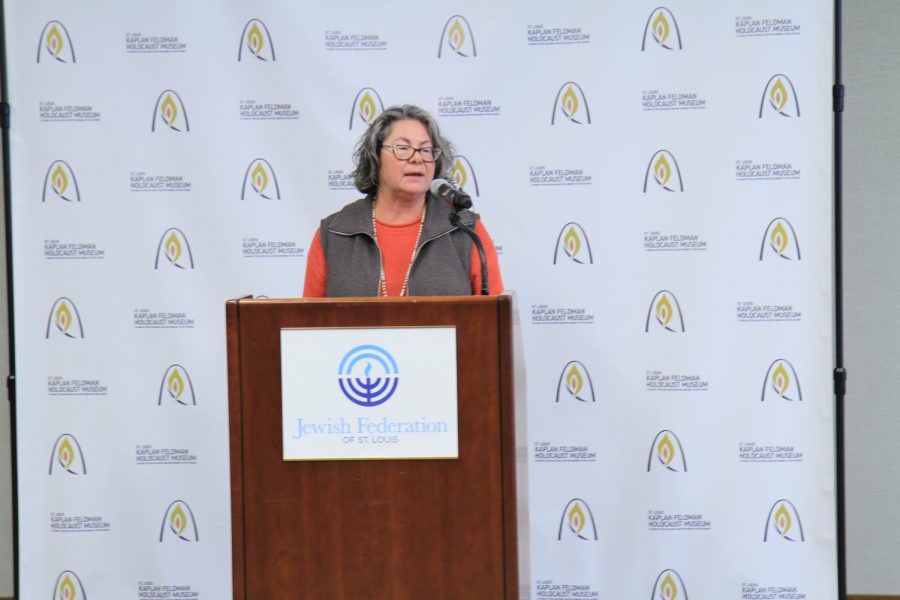Holocaust Museum receives long-lost bracelet secretly crafted in concentration camp
Published April 9, 2021
When Sharon Berry was reviewing her emails in July 2018, she paused at one from the organization that oversees a memorial at the former Buchenwald concentration camp and thought, “This must be a sick joke,” she recalled recently.
It was about a bracelet that contained her father’s prisoner identification number. It did not turn out to be a sick joke, but rather just the opposite.
Amidst the sickness of the Holocaust, the artifact appeared to be an example of an inmate, Ben Fainer, trying to find something to raise his spirits.
On Thursday, which was Yom HaShoah, Holocaust Remembrance Day, Berry delivered the bracelet to the focal point of the community that invigorated him later in life: the St. Louis Kaplan Feldman Holocaust Museum.
“He suffered so much and to have the light stolen from your soul and from your life,” Berry said of her father who survived five concentration camps. “This community here gave him back his light.”
Fainer, who was born in Bedzin, Poland, near Poland’s border with Germany, was liberated by the U.S. Army from a death march near Buchenwald in 1945. But his mother, three siblings and hundreds of relatives were killed.
After the war, Fainer did not discuss the trauma he suffered for six decades.
He moved to St. Louis in 1957. Once he started to share his story here, “he spoke to thousands of visitors to the museum who were all really amazed and drawn to him. He had been in five concentration camps and yet he had this great appreciation for life and was funny and charming and really showed what resilience looked like,” said Dan Reich, the museum’s curator and director of education.
Some might say that resilience also looks like the silver bracelet that not only had one of the ultimate markers of depravity, the prisoner ID numbers, which were often tattooed on inmates’ arms. It also had decorative notching and dots shaped like a starburst effect.
“It clearly wasn’t just a piece of jewelry,” Reich said. Fainer had worked in a metalworks factory while at Blechhammer, a satellite camp of the Auschwitz-Birkenau concentration camp.
“Did he make it himself and add those [decorative] elements?” Reich wondered.
But Fainer, who spent his career in the garment industry and died in 2016 at age 86, never spoke about the bracelet, so Reich and Berry don’t know the answer.
It was discovered on an archaeological dig at the Buchenwald site in the 1990s and turned over to the memorial organization, Berry said. Decades later, Dr. Sven Bayer, the German doctor who discovered the artifact, found a photo of the bracelet in his office and reached out to the Buchenwald memorial organization and asked: what happened to that?
After that long lull, the next steps happened rather quickly.
Prompted by the call, staff at the memorial unpacked the bracelet and started to do some research. The bracelet contained a variation on Fainer’s name and his mother maiden’s name, Beniek Urman, so using that and the ID number, the staff found a YouTube video that Erich Vieth, a St. Louis attorney, had produced telling Fainer’s story. They were eventually able to reach Berry, who lives in Philadelphia.
In October 2019, Berry traveled to Germany to retrieve the bracelet and learn more about her father’s story. Bayer, the German physician who discovered the bracelet, also traveled several hours to Buchenwald to meet Berry.
“Being on the grounds of Buchenwald where my father was imprisoned was very emotional,” recalled Berry, who with two of her sisters founded the Hannah Ida Urman Foundation, which in memory of their grandmother sponsors Holocaust education programs.
After acquiring the bracelet, Berry, who lives in Philadelphia, knew where to bring it: the Holocaust museum in St. Louis.
“To see how he devoted himself to this community, and all the speaking that he did, how that healed him and what that did for his life — his soul is there,” Berry said.
As Reich put it, “If this is where part of his spirt dwells, it’s appropriate that the bracelet will now be there as well.”
















